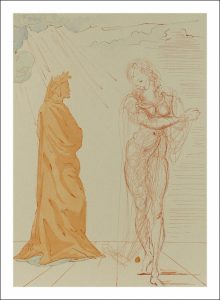The above Dali illustration is of Dante and Beatrice from the Divine Comedy. Dali has been described a mystic Catholic by some and a superstitious Catholic by others. In 1957, the Italian government approached Salvador Dali to produce a series of 101 watercolor illustrations intended to accompany a new edition of the Divine Comedy intended to celebrate the 700th anniversary of Dante’s birth in 1965. Dali set to work. But when the first of Dali’s paintings were exhibited at the Palazzo Pallavicini in Rome, a section of the Italian public were disgusted that a Spaniard had been hired to celebrate their country’s greatest poet rather than some Italian. The project was quickly dropped. However, Dali seemed unperturbed. He finished the project.
In 1964, Dali approached his French publisher, Joseph Foret, who was then producing a volume of Dali’s illustrations to accompany a new edition of Don Quixote. Dali suggested the idea of publishing his illustrations in a new edition of Dante’s epic poem. Foret took a selection of Dali’s watercolors to the publishers Les Heures Claires—who were equally enthusiastic about the project. Two engravers—Raymond Jacquet with his assistant, Mr. Taricco—were hired to hand carve the 3,500 wood blocks necessary to reproduce Dali’s watercolors. A limited edition of the book was published in Italian.
Dali’s illustrations feature many of his trademark images—elongated limbs, melting faces, and disturbing unquiet. Though his paintings do not attempt to compete with the illustrations of Dore and Blake—Dali’s images do create a surreal interpretation of Hell and all its punishments. Below is the complete set of Dali’s illustrations for the first part of Dante’s Divine Comedy—the Inferno—as recounts the poet’s journey from dark wood through the gates of the underworld onto the nine circles of Hell.
To read more and see the Dali’s illlustrations – http://dangerousminds.net/comments/salvador_dali_goes_to_hell_astounding_illustrations_for_dantes_inferno


